Explore Kanchanaburi - Thailand Travel, Asia
Tucked away in western Thailand, Kanchanaburi is a mesmerizing location that skillfully combines colorful culture, stunning scenery, and a long history. Known for its iconic role in World War II and the famous Death Railway, this charming town offers much more than just historical significance. From lush national parks to serene riverside landscapes, Kanchanaburi beckons travelers with an array of experiences waiting to be discovered. Let’s embark on a journey to explore the unique charm and allure of this must-visit destination of Thailand.
Population: Approximately 900,000 in 2018.
Economy: Kanchanaburi’s economy thrives on tourism, agriculture, and local crafts. Key sectors include hospitality, local markets, and small industries, supporting both visitors and the community.
Landmarks: Famous for the Bridge over the River Kwai, Hellfire Pass Memorial Museum, and Erawan National Park.
Thailand
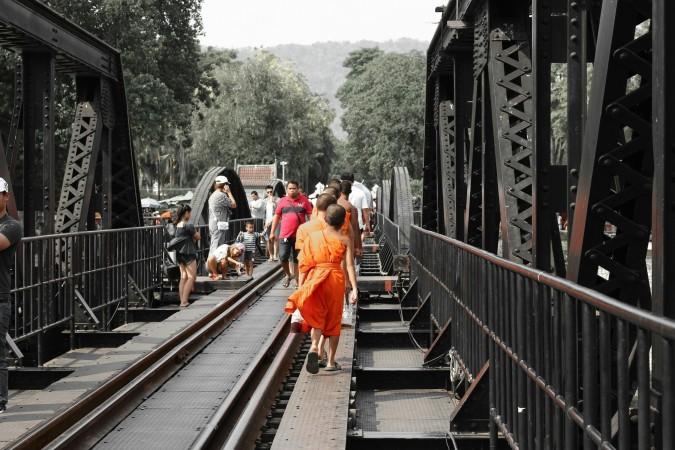
Overview of Kanchanaburi
History & Cultural Influence
Kanchanaburi’s history is deeply rooted in the events of World War II, making it a place of profound significance. The capital town of Kanchanaburi is best known for the Death Railway, a tragic yet pivotal part of its past. Constructed by Allied prisoners of war under harrowing conditions, the railway and the infamous Bridge over the River Kwai have become poignant symbols of the town's historical narrative. But Kanchanaburi’s story doesn’t end with war. The blend of Thai, Mon, and Burmese traditions is reflected in the local architecture, festivals, and daily life, offering visitors a rich tapestry of cultural experiences. From the sacred temples that dot the landscape to the vibrant festivals that celebrate local customs, Kanchanaburi's culture is both diverse and deeply rooted in tradition.
Interaction with The Locals
There are about 900,000 people living in Kanchanaburi province, who come from a varied background. The citizens are predominantly Thai, with a mix of ethnic groups including Mon, Burmese, and Karen communities. This cultural diversity enriches the town's traditions, languages, and festivals, making it a vibrant and welcoming place for visitors. The people of Kanchanaburi are known for their warmth, hospitality, and strong sense of community, deeply rooted in their historical and cultural heritage.
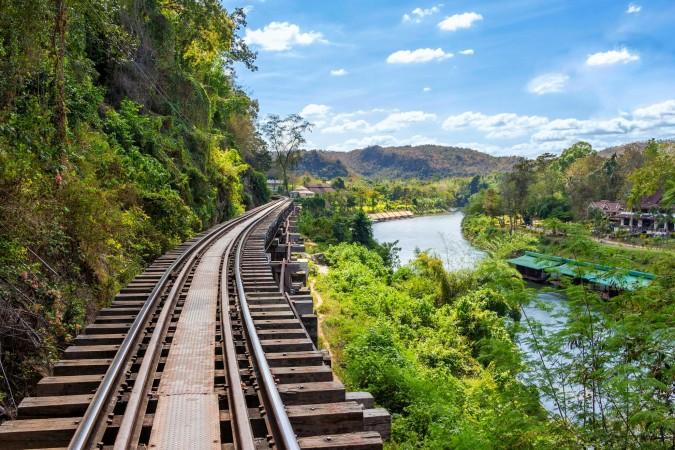
Kanchanauri's natural beauty - © Maria Krasnova
Top Attractions in Kanchanaburi
Kanchanaburi is brimming with attractions that cater to all interests, whether you're drawn to history, nature, or spirituality. With a look into the many dimensions of Kanchanaburi provided by each of these attractions, Kanchanaburi is an enlightening and fascinating vacation.
Historical Sites in Kanchanaburi
- Bridge over the River Kwai: This iconic bridge, part of the Death Railway, stands as a testament to the resilience of those who suffered during World War II. Walking across the bridge is both a humbling and awe-inspiring experience.
- Hellfire Pass Memorial Museum: Located in the rugged terrain of the Tenasserim Hills, this museum provides a poignant look into the lives of the prisoners of war who were forced to construct the railway. The museum offers a deep and moving narrative, making it a must-visit for history enthusiasts.
Natural Wonders in Kanchanaburi
- Erawan National Park: Famous for its seven-tiered waterfall, Erawan National Park is a haven for nature lovers. The park’s emerald green waters and lush forest trails make it a perfect spot for hiking, swimming, and wildlife spotting.
- Sai Yok Waterfalls: A serene escape, these waterfalls are ideal for those looking to unwind amidst nature. The area also offers boat tours along the River Kwai, providing a unique perspective of Kanchanaburi’s natural beauty.
Cultural Sites in Kanchanaburi
- Wat Tham Sua (Tiger Cave Temple): Perched on a hilltop, this temple offers panoramic views of the surrounding countryside. The temple is known for its stunning Buddha statue and intricate architecture, making it a spiritual and visual highlight of any trip to Kanchanaburi.
- Wat Tham Khao Pun: This temple, nestled in a cave, offers a peaceful retreat for meditation. The cave’s natural formations and the temple’s serene atmosphere provide a unique spiritual experience.
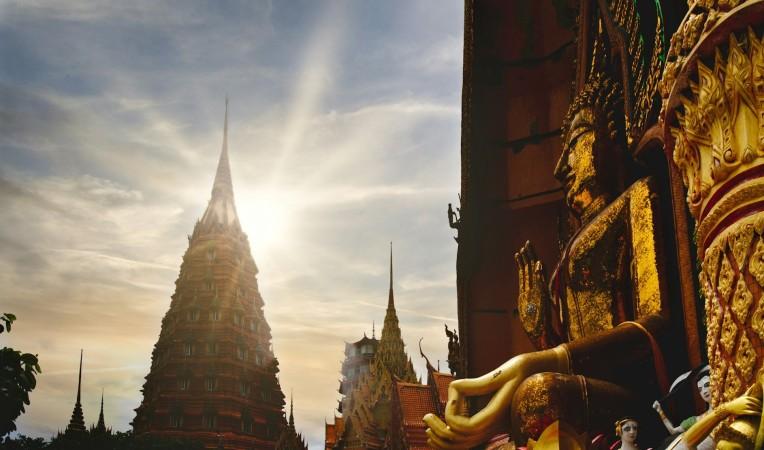
Wat Tham Sua (Tiger Cave Temple) - © Joran Quinten
Must-Try Dishes in Kanchanaburi
Kanchanaburi's cuisine is a delicious fusion of traditional Thai flavors with local specialties. The town offers an array of must-try local dishes that provide a genuine taste of the region.
- Khao Lam: A local favorite, Khao Lam is sticky rice mixed with coconut milk, packed into bamboo tubes, and slow-cooked over an open fire. The ultimate result is a sweet and aromatic meal with a mild smokey flavor that is frequently served as a snack or dessert.
- Gaeng Pha (Jungle Curry): This spicy, coconut milk-free curry is packed with local herbs, wild vegetables, and sometimes, wild meats. Gaeng Pha is known for its robust and fiery taste, making it a thrilling dish for those who love heat in their meals.
- Sai Ua (Northern Thai Sausage): Though originally from Northern Thailand, Sai Ua has found its place in Kanchanaburi’s cuisine. This flavorful sausage is made from minced pork, mixed with herbs and spices, then grilled. The result is a savory and aromatic treat that’s perfect on its own or with sticky rice.
- Som Tum (Papaya Salad): A staple of Thai street food, Som Tum is a spicy and tangy salad made from shredded green papaya, mixed with lime, chili, peanuts, and fish sauce. It’s a refreshing dish that balances flavors beautifully.
- Khanom Krok (Coconut Pancakes): These bite-sized coconut pancakes are crispy on the outside and soft on the inside. They’re a popular snack in Kanchanaburi, often sold by street vendors and enjoyed as a sweet treat.
- Laab Pla (Spicy Fish Salad): Laab Pla is a zesty and spicy fish salad made with minced fish, herbs, lime juice, and roasted rice powder. It's a refreshing meal with robust tastes that wonderfully captures the native taste.

Sai Ua (Northern Thai Sausage) - © ChefSteps
Festivals & Local Celebrations
Kanchanaburi’s festivals are vibrant expressions of its rich cultural traditions and historical significance. Participating in these celebrations offers a deeper connection to the local way of life and the town’s enduring spirit.
River Kwai Bridge Week
Held annually in late November to early December, this festival commemorates the history of the Death Railway and the Bridge over the River Kwai. The event features a light and sound show that recreates wartime history, along with exhibitions, parades, and cultural performances. It’s a poignant yet celebratory occasion that honors the resilience of those who lived through this dark chapter.
Loi Krathong
Celebrated on the full moon night of the 12th lunar month, Loi Krathong is one of Thailand’s most enchanting festivals. In Kanchanaburi, locals and visitors alike float decorated baskets (krathongs) on the River Kwai as a symbol of letting go of past misfortunes and making wishes for the future. The sight of thousands of glowing krathongs drifting down the river is a magical experience.
Songkran Festival (Thai New Year)
Mid-April comes Songkran, a joyful celebration of the Thai New Year marked by religious activities and water battles. In Kanchanaburi, locals engage in friendly water battles on the streets, visit temples to make merit, and pay respects to their elders. It’s a time of renewal and communal joy, offering visitors a chance to experience Thai culture at its most exuberant.
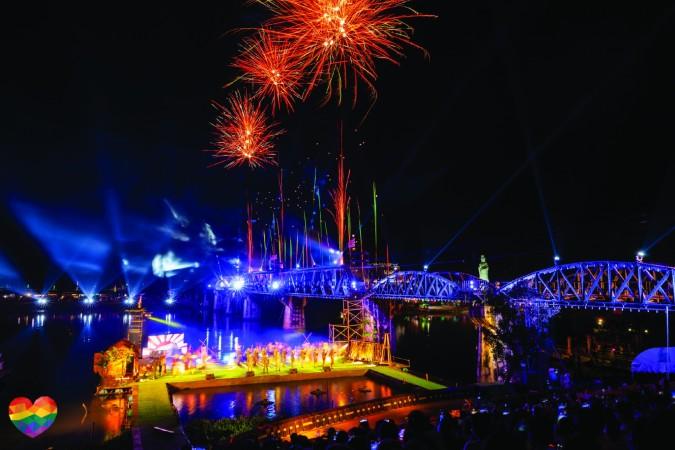
River Kwai Bridge Week - © Thailand Tourism
What to Do in Kanchanaburi
Kanchanaburi offers a wide range of activities that cater to all types of travelers, whether you’re seeking adventure, relaxation, or a deeper cultural experience.
- Trekking and Hiking: Kanchanaburi’s lush landscapes make it a prime destination for outdoor enthusiasts. Erawan National Park and Sai Yok National Park offer numerous trails that lead to stunning waterfalls, caves, and viewpoints. These treks vary in complexity, making them suitable for both casual walkers and expert hikers.
- Bamboo Rafting: For a unique experience, try bamboo rafting along the River Kwai. This activity offers a serene way to enjoy the natural beauty of Kanchanaburi while floating down the river on a traditional bamboo raft.
- Elephant Sanctuaries: Ethical elephant tourism is growing in Kanchanaburi, with sanctuaries that offer visitors the chance to interact with these majestic creatures in a humane and responsible manner. Activities typically include feeding, bathing, and learning about elephant conservation efforts.
- Spa Retreats: After a day of exploration, unwind at one of Kanchanaburi’s riverside resorts, many of which offer spa services that incorporate traditional Thai massage and herbal treatments. These retreats provide a peaceful escape and a chance to rejuvenate in a tranquil setting.
Shopping in Kanchanaburi
Shopping in Kanchanaburi is not just about buying items; it’s an opportunity to immerse yourself in the local culture, support local artisans, and bring home a piece of your journey.
- Kanchanaburi Night Market: This bustling market is a must-visit for anyone looking to experience local life. Here, you can find a variety of goods including clothing, accessories, handicrafts, and an array of delicious street food. The vibrant atmosphere and friendly vendors make it an enjoyable shopping experience.
- JJ Green Market: A smaller, more laid-back market, JJ Green is known for its vintage goods, antiques, and artisanal products. It’s a great place to pick up unique souvenirs and gifts that reflect the local culture.
- Tha Ma Kham Market: Located near the Bridge over the River Kwai, this market is popular among tourists and offers a range of items including souvenirs, local snacks, and handmade crafts. It’s also a good spot to try local dishes at the various food stalls.
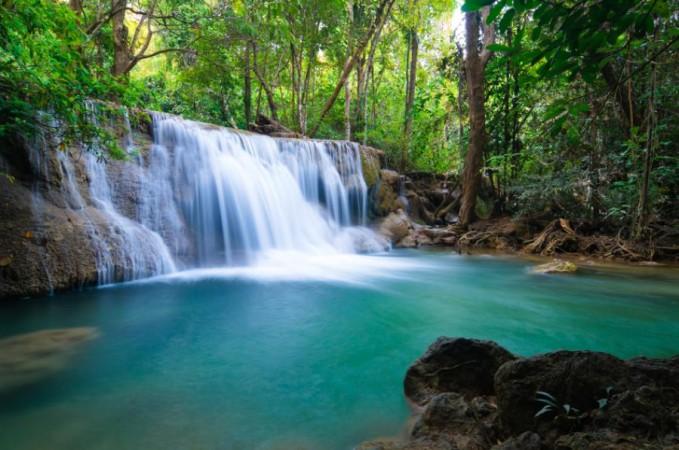
Erawan National Park - © Thai National Parks
Weather in Kanchanaburi: Best Time to Visit
Kanchanaburi enjoys a tropical climate, characterized by three main seasons: the cool season, the hot season, and the rainy season. Understanding the weather patterns can help you plan your visit to ensure the best experience.
Cool Season in Kanchanaburi
The cool season is the most popular time to visit Kanchanaburi. During these months, temperatures range from 20°C to 30°C (68°F to 86°F), offering pleasant weather for outdoor activities and sightseeing. The cool breezes and lower humidity make it an ideal time to explore the town’s historical sites, national parks, and enjoy river cruises.
Hot Season in Kanchanaburi
The hot season in Kanchanaburi sees temperatures soaring to around 35°C to 40°C (95°F to 104°F). While it can be quite warm, it’s still a good time to visit if you plan on enjoying water-based activities like rafting or swimming in the waterfalls. Just be sure to stay hydrated and take breaks in the shade during the hottest part of the day.
Wet Season in Kanchanaburi
The rainy season brings frequent showers and occasional heavy rainfall, with temperatures ranging between 25°C and 33°C (77°F to 91°F). While the rain can be unpredictable, it also brings lush greenery to the region, making the landscapes particularly beautiful. It’s a quieter time to visit, with fewer tourists, and you can enjoy the natural beauty of Kanchanaburi’s waterfalls and rivers at their fullest.
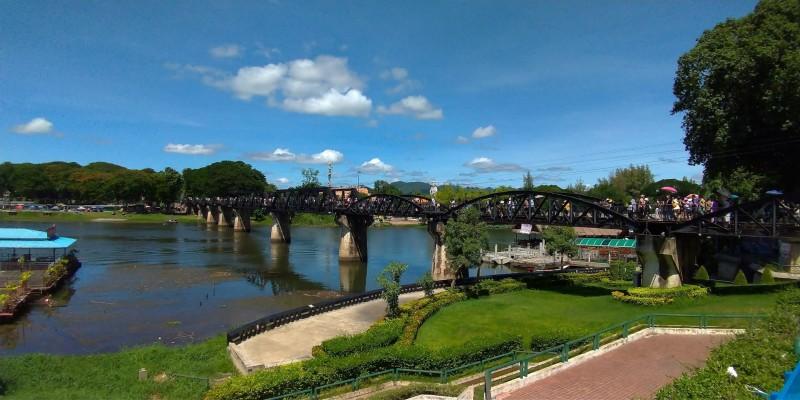
River Kwai Bridge on a clear day - © Hata Life
Essential Travel Information
Getting Around Kanchanaburi
- Songthaews: These retrofitted pickup trucks function as shared taxis and are a popular means of transportation in Kanchanaburi. They follow set routes and are an affordable way to get around town. Simply hop on and pay a small fare when you reach your destination.
- Tuk-tuks: Tuk-tuks are a popular and memorable method to travel small distances in Kanchanaburi. They’re especially useful for getting to attractions that are slightly off the beaten path. Fares can be negotiated, so it’s a good idea to agree on a price before starting your journey.
- Buses: Kanchanaburi has a well-connected bus system that links the town with surrounding areas and Bangkok. Local buses are an economical way to travel, though they may take longer than other methods. For journeys across regions, air-conditioned buses are available and provide a more pleasant experience.
- Motorbike Rentals: Renting a motorbike is a popular option for those who want to explore Kanchanaburi at their own pace. Motorbikes are widely available for rent and offer the flexibility to visit attractions that might be difficult to reach by public transport.
- Bamboo Rafts: For a unique experience, bamboo rafts offer a traditional way to explore the rivers around Kanchanaburi. They’re a slower, more leisurely mode of transport, perfect for taking in the scenic beauty of the region.
ATM & Banking Services
Kanchanaburi offers convenient access to ATM and banking services, with numerous ATMs available throughout the town, particularly in central areas and near tourist spots. These ATMs generally accept international cards, making it easy for travelers to withdraw local currency. However, be aware of transaction fees that may apply for foreign cards. Additionally, currency exchange services can be found at banks, exchange counters, and some hotels, allowing visitors to manage their finances smoothly. While credit cards are widely accepted in larger establishments, it’s advisable to carry some cash for smaller businesses and local markets that may not accept cards.
Where to Stay in Kanchanaburi
- Luxury Stays: For those seeking a premium experience, Kanchanaburi’s riverside resorts provide stunning views of the river, top-notch amenities, and a serene environment. These resorts often feature spacious rooms, private balconies, swimming pools, and spa services, ideal for a relaxing and indulgent stay.
- Mid-Range Options: If you prefer comfort with good value, mid-range riverside resorts offer cozy accommodations with beautiful river views. These options typically provide essential amenities such as comfortable rooms, on-site dining, and recreational facilities, offering a pleasant stay without the high price tag.
- Boutique Hotels: Boutique hotels in Kanchanaburi are perfect for travelers who enjoy unique and stylish lodgings. These smaller hotels often reflect the local culture and history, offering personalized service, distinctive decor, and an intimate atmosphere that enhances the overall experience.
- Guesthouses & Hostels: For those traveling on a budget, Kanchanaburi’s guesthouses and hostels offer affordable and clean options. These are ideal for backpackers and solo travelers, featuring basic amenities and a social atmosphere that encourages interaction with fellow travelers.
- Homestays: Staying with a host family allows you to learn about local customs, enjoy home-cooked meals, and gain insights into daily life in the region. Homestays are a great way to connect with the community and experience Thai hospitality up close.
Articles for you

Explore Yala National Park - Sri Lanka Travel, Asia
Tucked away in Sri Lanka’s southeastern corner, Yala National Park is where wild nature meets deep tradition. Known worldwide for its leopard population, the park is also home to elephants, sloth bears, crocodiles, and hundreds of bird species. Beyond wildlife, Yala opens doors to a cultural landscape dotted with ancient temples, Buddhist ruins, and coastal villages. For travelers seeking more than just a safari, Yala offers a chance to explore eco-tourism, local communities, and sacred heritage sites.
Population: The Yala National Park area doesn’t have a human population.
Economy: The economy around Yala National Park thrives on a blend of eco-tourism, agriculture, and local services. Safari tours, eco-lodges, and cultural experiences drive steady income for nearby towns like Tissamaharama and Kataragama, supporting thousands of families.
Landmarks: Famous for Block I of Yala and wildlife encounters, including elephants, sloth bears, crocodiles, and exotic bird species.

Explore Galle - Sri Lanka Travel, Asia
Nestled on Sri Lanka’s southern coastline, Galle is a vibrant city where history meets the sea. Its cobbled streets, colonial architecture, and serene beaches make it a must-visit destination for travelers seeking a blend of culture, adventure, and relaxation. A UNESCO World Heritage site, Galle captivates visitors with its Dutch Fort, bustling markets, and friendly locals. Whether you’re exploring the ramparts at sunset or savoring fresh seafood by the shore, Galle promises an unforgettable journey into Sri Lanka’s heritage.
Population: Approximately 113,000 in 2023.
Economy: Galle’s economy thrives on tourism, trade, and fisheries. The city’s historic fort, colonial architecture, and coastal charm draw thousands of international visitors each year, making tourism its main economic driver. Fishing remains vital for local livelihoods, supplying fresh seafood across the region.
Landmarks: Famous for the Galle Fort, Dutch Reformed Church & Maritime Museum, and Unawatuna Beach.

Explore Bentota - Sri Lanka Travel, Asia
Nestled along Sri Lanka’s southwestern coast, Bentota is a tropical paradise that blends golden beaches, vibrant culture, and thrilling adventures. Famous for its calm waters, luxury resorts, and scenic river estuary, Bentota has become a top destination for travelers seeking both relaxation and authentic experiences. From serene beach walks at sunrise to adrenaline-pumping water sports, this coastal town offers a perfect balance of leisure and exploration. With its proximity to Colombo and Galle, Bentota is easy to reach, making it an ideal stop for both short escapes and extended holidays.
Population: Approximately 37,000 in 2023.
Economy: Bentota’s economy thrives mainly on tourism, which drives local businesses such as hotels, restaurants, and wellness retreats. The town also benefits from fishing, coconut cultivation, and handicrafts like wood carving and batik textiles. Many residents rely on the growing demand for water sports and Ayurvedic treatments, making tourism the backbone of both income and employment in the area.
Landmarks: Famous for Bentota Beach, Bentota River Safari, and Kande Vihara Temple.

Explore Mirissa - Sri Lanka Travel, Asia
Mirissa is a charming coastal town on Sri Lanka’s southern shoreline. Known for its golden beaches, turquoise waters, and vibrant marine life, it has become a must-visit stop for travelers exploring the island. Many come for whale watching, surfing, and sunset views at Coconut Tree Hill, but Mirissa offers much more than postcard beauty. The fishing boats you see anchored by the bay carry generations of stories. Local traditions, delicious cuisine, and a laid-back rhythm of life shape every visitor’s experience.
Population: Approximately 4,700 in 2023.
Economy: Mirissa’s economy is largely shaped by its coastal location. Fishing has long been the backbone of local livelihoods, with generations relying on the Indian Ocean for income. In recent decades, tourism has become the main driver of growth, thanks to whale watching, surfing, and beachside hospitality.
Landmarks: Famous for Mirissa Beach, Coconut Tree Hill, and Parrot Rock Bridge.

Explore Nuwara Eliya - Sri Lanka Travel, Asia
Tucked away in the Central Highlands of Sri Lanka, Nuwara Eliya is often called “Little England”. With its rolling tea plantations, cool misty mornings, and colonial charm, this mountain town feels like a step into another world. Travelers come here to breathe fresh air, walk through flower gardens, sip the finest Ceylon Tea, and enjoy a pace of life far from the island’s busy cities. Whether you’re drawn by scenic landscapes, heritage architecture, or the warmth of its people, Nuwara Eliya is a destination that blends nature, culture, and history in perfect harmony.
Population: Approximately 781,000 in 2023.
Economy: Nuwara Eliya’s economy thrives mainly on tea production, as it sits in the heart of Sri Lanka’s central highlands, famous worldwide for Ceylon Tea. The city also benefits from a growing tourism industry, attracting visitors with its colonial charm, cool climate, and scenic landscapes.
Landmarks: Famous for Gregory Lake, Hakgala Botanical Garden, and Victoria Park.

Explore Sukau - Malaysia Travel, Asia
Nestled on the banks of the Kinabatangan River in Sabah, Malaysian Borneo, Sukau is a destination where wildlife, culture, and conservation come together. Known as one of Asia’s top spots for river safaris and eco-tourism, this quiet village offers a front-row seat to encounters with Bornean orangutans, pygmy elephants, proboscis monkeys, and exotic birdlife.
Population: Approximately 1,400 in 2019.
Economy: Sukau’s economy is shaped by its riverine location and natural resources. Traditionally, the Orang Sungai community relied on fishing, small-scale farming, and forest gathering for their livelihood. Today, the village has shifted toward eco-tourism, with river cruises, jungle trekking, and homestays providing income.
Landmarks: Famous for the Kinabatangan River cruises, Gomantong Caves, and Ox-bow lakes and wetlands.
